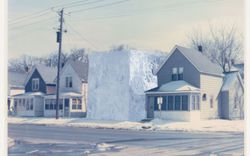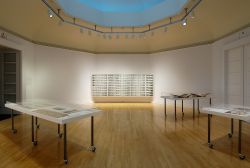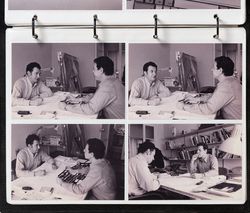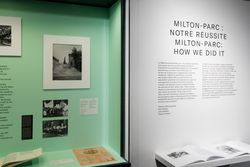archives
Level of archival description:
Fonds
Lars Spuybroek fonds
AP173
Synopsis:
The Lars Spuybroek fonds documents the professional practice of architect Lars Spuybroek from his early projects in the 1990s to projects undertaken with his firm NOX from 1995 to 2010. The majority of the documents in the fonds consist of photographic materials, drawings and textual records relating to over 70 projects, such as the H2Oexpo in Neeltje Jans Island, Netherlands (1997), the Maison Folie in Nantes, France (2001) and the D-Tower in Doetinchem, Netherlands (2004).
1980s-2010
Lars Spuybroek fonds
Actions:
AP173
Synopsis:
The Lars Spuybroek fonds documents the professional practice of architect Lars Spuybroek from his early projects in the 1990s to projects undertaken with his firm NOX from 1995 to 2010. The majority of the documents in the fonds consist of photographic materials, drawings and textual records relating to over 70 projects, such as the H2Oexpo in Neeltje Jans Island, Netherlands (1997), the Maison Folie in Nantes, France (2001) and the D-Tower in Doetinchem, Netherlands (2004).
archives
Level of archival description:
Fonds
1980s-2010
Sub-series
AP140.S2.SS10.D2
Description:
This sub-series documents some of the reference materials used or collection during the activities and procedures of the successive firms of James Stirling; James Stirling and Partner; James Stirling, Michael Wilford, and Associates; and Michael Wilford and Partners. Material in this file was produced between 1957 and 1998. Sub-series contains reference materials including typescripts dated from the early 1960s, articles and drafts of articles, translations, publications, regulations, postcards and invitation cards. It contains also materials from the surviving office library of James Stirling and Michael Wilford as it existed in 2000 when it was housed at 8 Fitzroy Square in London. During the processing the office library, a selection publications were transferred in the CCA library collection to facilitate description and access. This sub-series contains part of the published materials that remained in the archives.
1962-1995
Reference materials and library
Actions:
AP140.S2.SS10.D2
Description:
This sub-series documents some of the reference materials used or collection during the activities and procedures of the successive firms of James Stirling; James Stirling and Partner; James Stirling, Michael Wilford, and Associates; and Michael Wilford and Partners. Material in this file was produced between 1957 and 1998. Sub-series contains reference materials including typescripts dated from the early 1960s, articles and drafts of articles, translations, publications, regulations, postcards and invitation cards. It contains also materials from the surviving office library of James Stirling and Michael Wilford as it existed in 2000 when it was housed at 8 Fitzroy Square in London. During the processing the office library, a selection publications were transferred in the CCA library collection to facilitate description and access. This sub-series contains part of the published materials that remained in the archives.
File 2
1962-1995
archives
Level of archival description:
Fonds
Amancio Williams fonds
AP205
Synopsis:
The Amancio Williams fonds documents Williams' career as an architect and designer from the 1940s to the late 1980s. The fonds documents his work for over 80 architectural, urban planning and furniture design projects, as well as the administration of his architecture practice, and his professional activities through correspondence, photographic material, and promotional materials.
1848-2010s
Amancio Williams fonds
Actions:
AP205
Synopsis:
The Amancio Williams fonds documents Williams' career as an architect and designer from the 1940s to the late 1980s. The fonds documents his work for over 80 architectural, urban planning and furniture design projects, as well as the administration of his architecture practice, and his professional activities through correspondence, photographic material, and promotional materials.
archives
Level of archival description:
Fonds
1848-2010s
archives
Level of archival description:
Fonds
AP075
Synopsis:
The Cornelia Hahn Oberlander fonds documents Oberlander's professional activities as a landscape architect. It contains over 203 projects that span from 1950 to 2018 predominantly in Canada and in the United States, but also in Germany. The fonds is a complete record of Oberlander's work, and comprises her playground projects, roof gardens, and public space landscapes, as well as landscape designs for private residences, as well as administrative records from her practice, her professional engagements, and her research materials. The material in this fonds is dated from 1936 to 2021.
1936-2021
Cornelia Hahn Oberlander fonds
Actions:
AP075
Synopsis:
The Cornelia Hahn Oberlander fonds documents Oberlander's professional activities as a landscape architect. It contains over 203 projects that span from 1950 to 2018 predominantly in Canada and in the United States, but also in Germany. The fonds is a complete record of Oberlander's work, and comprises her playground projects, roof gardens, and public space landscapes, as well as landscape designs for private residences, as well as administrative records from her practice, her professional engagements, and her research materials. The material in this fonds is dated from 1936 to 2021.
archives
Level of archival description:
Fonds
1936-2021
articles
archives
Level of archival description:
Fonds
Gene Summers fonds
AP114
Synopsis:
The Gene Summers fonds documents primarily the later part of Gene Summers' career as an architect, developer, artist and art collector. Summer's early work with the Office of Mies van der Rohe and C.F. Murphy Associates is summarily represented by notes, sketches and photographs.
1957 - 2004
Gene Summers fonds
Actions:
AP114
Synopsis:
The Gene Summers fonds documents primarily the later part of Gene Summers' career as an architect, developer, artist and art collector. Summer's early work with the Office of Mies van der Rohe and C.F. Murphy Associates is summarily represented by notes, sketches and photographs.
archives
Level of archival description:
Fonds
1957 - 2004
German artist Dieter Appelt presents a major work commissioned by the CCA and inspired by the late nineteenth-century Forth Rail Bridge near Edinburgh, Scotland. Dieter Appelt: Forth Bridge — Cinema. Metric Space is the second of four exhibitions in the Tangent series, which brings contemporary artists into dialogue with the CCA Collection and results in newly(...)
Octagonal gallery
9 March 2005 to 22 May 2005
Dieter Appelt: Forth Bridge - Cinema. Metric Space
Actions:
Description:
German artist Dieter Appelt presents a major work commissioned by the CCA and inspired by the late nineteenth-century Forth Rail Bridge near Edinburgh, Scotland. Dieter Appelt: Forth Bridge — Cinema. Metric Space is the second of four exhibitions in the Tangent series, which brings contemporary artists into dialogue with the CCA Collection and results in newly(...)
Octagonal gallery
Join us in Madrid for a conversation with Iñaki Ábalos and Juan Herreros, with the participation of Ángel Borrego, Enrique Encabo, Albert Ferré (Associate Director, CCA Publications), María Auxiliadora Gálvez, and Moisés Puente. “Is there such a thing as an architecture of conversation?” ask Iñaki Ábalos and Juan Herreros in their text “A Conversation,” published in CIRCO(...)
7 February 2017, 7pm
AP164: A Conversation with Iñaki Ábalos and Juan Herreros
Actions:
Description:
Join us in Madrid for a conversation with Iñaki Ábalos and Juan Herreros, with the participation of Ángel Borrego, Enrique Encabo, Albert Ferré (Associate Director, CCA Publications), María Auxiliadora Gálvez, and Moisés Puente. “Is there such a thing as an architecture of conversation?” ask Iñaki Ábalos and Juan Herreros in their text “A Conversation,” published in CIRCO(...)
Project
AP198.S1.1997.PR02
Description:
Project records document the design process for OCEAN North’s competition entry for the Jyväskylä Music and Arts Centre in 1997. The project was titled Terra Cultura by OCEAN North. The international competition called to create a multi-usage space that would include a venue for the symphonic orchestra, a music school, exhibition spaces, and the possibility to host a variety of small cultural events in the Finnish city of Jyväskylä. The proposed site is in the center of the town, across the street from the Jyväskylä city church and its park, and nearby buildings designed by Alvar Aalto. OCEAN North’s concept presents a topological surface as an extension of the surrounding urban scape with two masses that would host the formal functions of the building (concert hall, music school, exhibition halls). The two volumes, or raised blocks, are divided along a diagonal elevated space, which is the extension of the ground’s topological surface filled and dubbed “Liquid Flow Space” by the design team. In their interview with Greg Lynn, Johan Bettum and Kivi Sotamaa mentioned that the idea for Jyväskylä was that it was a cloud. Digital files, in particular, show the process to achieve the projected design. Drawings provide views of streamed particles and of resulting peels. They also include plans, elevations and axonometric views of the structure. Most files are raster or vector images, likely saved from CAD software. A few files are in CAD formats such as Microstation, 3D Studio and form*Z. Digital files also present sine wave analysis and resulting charts for each component of the program. The analysis and charts present the relationships between various components of the building’s program such as the Art Museum, the Concert Halls, the technical space, and the Common facilities. These files are raster images and spreadsheets. Photographs of the site in Jyväskylä and of models built by OCEAN North were digitized and are included with the digital working files. Physical drawings are chiefly floor plans for the building, but also include sections and sketches. Finally, project files include photographic prints of two built models. One of these models, a small model of the conceptual masses of the building structure, is itself in the archive. Photographs show the model in the context of a city scape model. The second model, not part of the archive at CCA, was built at a bigger scale and was an intricate cardboard and wooden stick structure. Sources: Softspace: from a representation of form to a simulation of space, Edited by Sean Lally and Jessica Young. London, New York: Routledge, 2007. Greg Lynn, ed. Archaeology of the Digital 17: OCEAN North, Jyväskylä Music and Arts Centre, Montréal: Canadian Centre for Architecture, 2017. ePub.
1997
Terra Cultura – Jyväskylä Music and Arts Centre, international competition entry
Actions:
AP198.S1.1997.PR02
Description:
Project records document the design process for OCEAN North’s competition entry for the Jyväskylä Music and Arts Centre in 1997. The project was titled Terra Cultura by OCEAN North. The international competition called to create a multi-usage space that would include a venue for the symphonic orchestra, a music school, exhibition spaces, and the possibility to host a variety of small cultural events in the Finnish city of Jyväskylä. The proposed site is in the center of the town, across the street from the Jyväskylä city church and its park, and nearby buildings designed by Alvar Aalto. OCEAN North’s concept presents a topological surface as an extension of the surrounding urban scape with two masses that would host the formal functions of the building (concert hall, music school, exhibition halls). The two volumes, or raised blocks, are divided along a diagonal elevated space, which is the extension of the ground’s topological surface filled and dubbed “Liquid Flow Space” by the design team. In their interview with Greg Lynn, Johan Bettum and Kivi Sotamaa mentioned that the idea for Jyväskylä was that it was a cloud. Digital files, in particular, show the process to achieve the projected design. Drawings provide views of streamed particles and of resulting peels. They also include plans, elevations and axonometric views of the structure. Most files are raster or vector images, likely saved from CAD software. A few files are in CAD formats such as Microstation, 3D Studio and form*Z. Digital files also present sine wave analysis and resulting charts for each component of the program. The analysis and charts present the relationships between various components of the building’s program such as the Art Museum, the Concert Halls, the technical space, and the Common facilities. These files are raster images and spreadsheets. Photographs of the site in Jyväskylä and of models built by OCEAN North were digitized and are included with the digital working files. Physical drawings are chiefly floor plans for the building, but also include sections and sketches. Finally, project files include photographic prints of two built models. One of these models, a small model of the conceptual masses of the building structure, is itself in the archive. Photographs show the model in the context of a city scape model. The second model, not part of the archive at CCA, was built at a bigger scale and was an intricate cardboard and wooden stick structure. Sources: Softspace: from a representation of form to a simulation of space, Edited by Sean Lally and Jessica Young. London, New York: Routledge, 2007. Greg Lynn, ed. Archaeology of the Digital 17: OCEAN North, Jyväskylä Music and Arts Centre, Montréal: Canadian Centre for Architecture, 2017. ePub.
Project
1997



